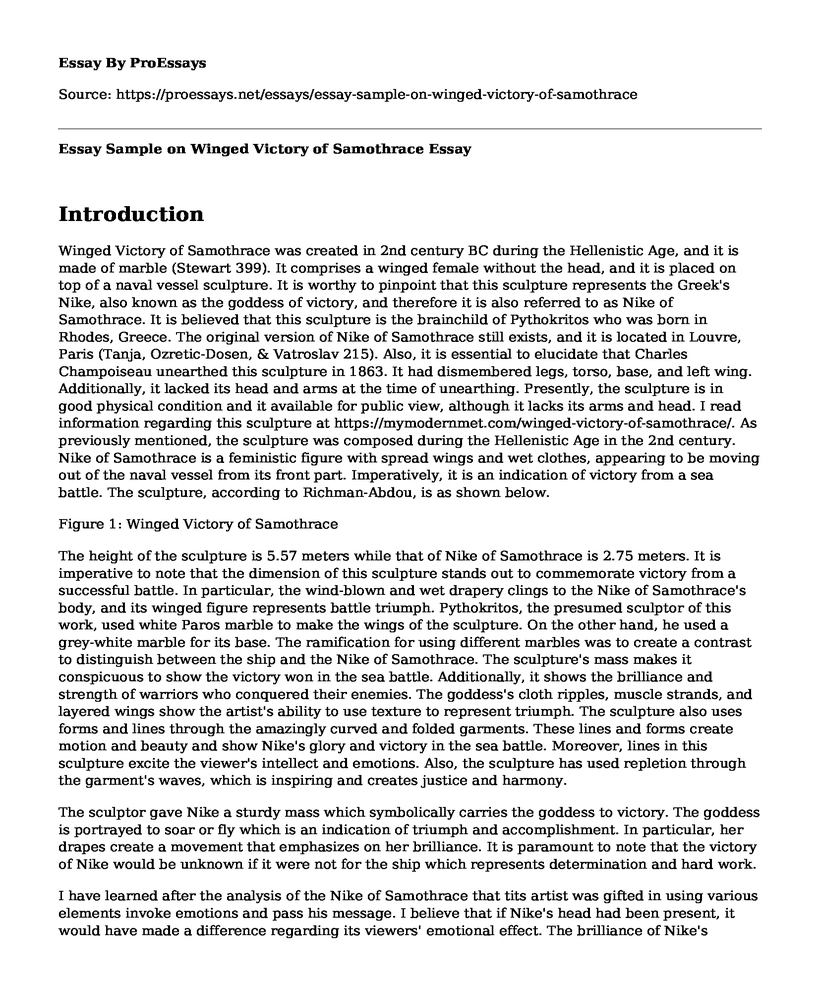Introduction
Winged Victory of Samothrace was created in 2nd century BC during the Hellenistic Age, and it is made of marble (Stewart 399). It comprises a winged female without the head, and it is placed on top of a naval vessel sculpture. It is worthy to pinpoint that this sculpture represents the Greek's Nike, also known as the goddess of victory, and therefore it is also referred to as Nike of Samothrace. It is believed that this sculpture is the brainchild of Pythokritos who was born in Rhodes, Greece. The original version of Nike of Samothrace still exists, and it is located in Louvre, Paris (Tanja, Ozretic-Dosen, & Vatroslav 215). Also, it is essential to elucidate that Charles Champoiseau unearthed this sculpture in 1863. It had dismembered legs, torso, base, and left wing. Additionally, it lacked its head and arms at the time of unearthing. Presently, the sculpture is in good physical condition and it available for public view, although it lacks its arms and head. I read information regarding this sculpture at https://mymodernmet.com/winged-victory-of-samothrace/. As previously mentioned, the sculpture was composed during the Hellenistic Age in the 2nd century. Nike of Samothrace is a feministic figure with spread wings and wet clothes, appearing to be moving out of the naval vessel from its front part. Imperatively, it is an indication of victory from a sea battle. The sculpture, according to Richman-Abdou, is as shown below.
Figure 1: Winged Victory of Samothrace
The height of the sculpture is 5.57 meters while that of Nike of Samothrace is 2.75 meters. It is imperative to note that the dimension of this sculpture stands out to commemorate victory from a successful battle. In particular, the wind-blown and wet drapery clings to the Nike of Samothrace's body, and its winged figure represents battle triumph. Pythokritos, the presumed sculptor of this work, used white Paros marble to make the wings of the sculpture. On the other hand, he used a grey-white marble for its base. The ramification for using different marbles was to create a contrast to distinguish between the ship and the Nike of Samothrace. The sculpture's mass makes it conspicuous to show the victory won in the sea battle. Additionally, it shows the brilliance and strength of warriors who conquered their enemies. The goddess's cloth ripples, muscle strands, and layered wings show the artist's ability to use texture to represent triumph. The sculpture also uses forms and lines through the amazingly curved and folded garments. These lines and forms create motion and beauty and show Nike's glory and victory in the sea battle. Moreover, lines in this sculpture excite the viewer's intellect and emotions. Also, the sculpture has used repletion through the garment's waves, which is inspiring and creates justice and harmony.
The sculptor gave Nike a sturdy mass which symbolically carries the goddess to victory. The goddess is portrayed to soar or fly which is an indication of triumph and accomplishment. In particular, her drapes create a movement that emphasizes on her brilliance. It is paramount to note that the victory of Nike would be unknown if it were not for the ship which represents determination and hard work.
I have learned after the analysis of the Nike of Samothrace that tits artist was gifted in using various elements invoke emotions and pass his message. I believe that if Nike's head had been present, it would have made a difference regarding its viewers' emotional effect. The brilliance of Nike's garment particularly makes me emotional regarding victory in a successful battle. Thus, the sculptor's work shows the glory that people have after a successful battle.
Works Cited
Richman-Abdou, Kelly, "This armless sculpture is one of the Louvre's most treasured masterpieces." Mymodrnmet.com, 2018. Available at: https://mymodernmet.com/winged-victory-of-samothrace/ (Accessed on February 6, 2019).
Stewart, Andrew. "The Nike of Samothrace: Another View." American Journal of Archaeology 120.3 (2016): 399-410.
Tanja, Komarac, Ozretic-Dosen Durdana, and Skare Vatroslav. "Understanding Competition and Service Offer in Museum Marketing." Academia, vol. 30, no. 2, 2017, pp. 215-230.
Cite this page
Essay Sample on Winged Victory of Samothrace. (2022, Nov 24). Retrieved from https://proessays.net/essays/essay-sample-on-winged-victory-of-samothrace
If you are the original author of this essay and no longer wish to have it published on the ProEssays website, please click below to request its removal:
- Profound Simplicity of Rowdy Herrington's Road House
- The Use of Comic in World War II Essay
- A Simple Plan by Sam Raimi Essay Example
- Essay Sample on Mahatma Gandhi: Fighting British Rule With Non-Cooperation
- The Golden Age of Japanese Cinema: 1950s Post-War Prosperity - Research Paper
- Early Years of War - Essay Sample
- Report on Revolutionary Alliance: Past and Present Goals for China's Liberation and Reconstruction







